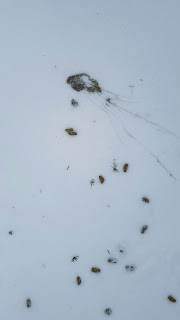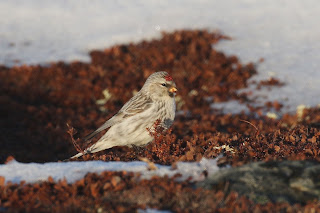--------------------------------------------------------------------------------
--------------------------------------------------------------------------------
The Arctic. It's an exhilarating and daunting place. The stakes are high. The birds are exhilarating. The thought of a nearby polar bear constantly lingers and hopes of a snow white gull keep one dreaming at night.
The sea ice. Always looming on the horizon as if waiting for an opportune moment to pile ashore. And when least expected it invades every last cove and inlet. Only to be frightened right back, like the tide, to its safe space on the horizon.
Life is different. Not only must it prepare for the regular prolonged arctic blasts, but it must contest with the unpredictable movement of sea ice and absolute lack of nourishment. How these animals survive is beyond me - but, sometimes, there are clues:
This image shows the droppings of a grouse - the large clump at the top is from the birds ceca.
Grouse (and other bird species) have outpouchings in their intestines called cecas. Grouse & Ptarmigan eat very tough food (tree twigs, etc) during the winter - they rely on the diversion of food into the pouches to break down the food over a long period of time so that they can absorb nutrients. In fact, their intestines grow to prepare for the winter and shrink by up to 50% in the spring!
Pine Grosbeaks continue to impress me as the most hardy of our finches.
Throughout this relatively bleak winter there were very few finches to be seen - the only finch species that I regularly encountered in the woods were Pine Grosbeaks. Despite the abysmal cone crop, and lack of other food they somehow eek out a living even as far North as St. Anthony!
Another exceptionally hardy species is the Snow Bunting.
A very appropriate name :)
It's not just the wildlife that impressed.
This fellow lives in the most Northerly house on the island of Newfoundland. Living just short of Cape Norman, he is not just isolated in rural Newfoundland - but lives about 5km from the closest community. He has lived here for over 50 years.
What a guy!
Guillemots:
Mmmmmmm... I saw this individual Gyrfalcon on 5 occasions. A real treat to have it around the community of St. Anthony where it kept a watchful eye on the daily Glaucous Gull commute.
American Three-toed Woodpecker!
One of the highlights of this trip was coming across this beauty of the dense spruce forests:
Sunny calm days made for some photogenic scenes:
L'Anse-aux-Meadows taking in the light show:
The snow storms were far beyond anything I had ever experienced before:
I did come across a few small flocks of pale redpolls - I'll leave it at that.
I'm very much "pro-OneRedpollSpecies"
The most spectacular birding came towards the end of my rotation.
As the ice continued to press closer to shore it drove eiders by the thousands close to land. Eventually they had no where to go but out over the ice to seek open water elsewhere.
The scenes were both dramatic and breath-taking with flocks in the thousands passing by the headlands.
This flock of over 5000 individual birds (image only shows 20% of flock) could be heard approaching from over 2km away - far before I saw them! These flocks most form annually in this area - creating one of Newfoundlands most impressive wildlife spectacles.
St. Carol's headland - probably the most exciting place in the area:
Iceland Gull:
Gyr:
Overall an excellent trip! But I'm definitely not hardy enough to be moving up there!

















